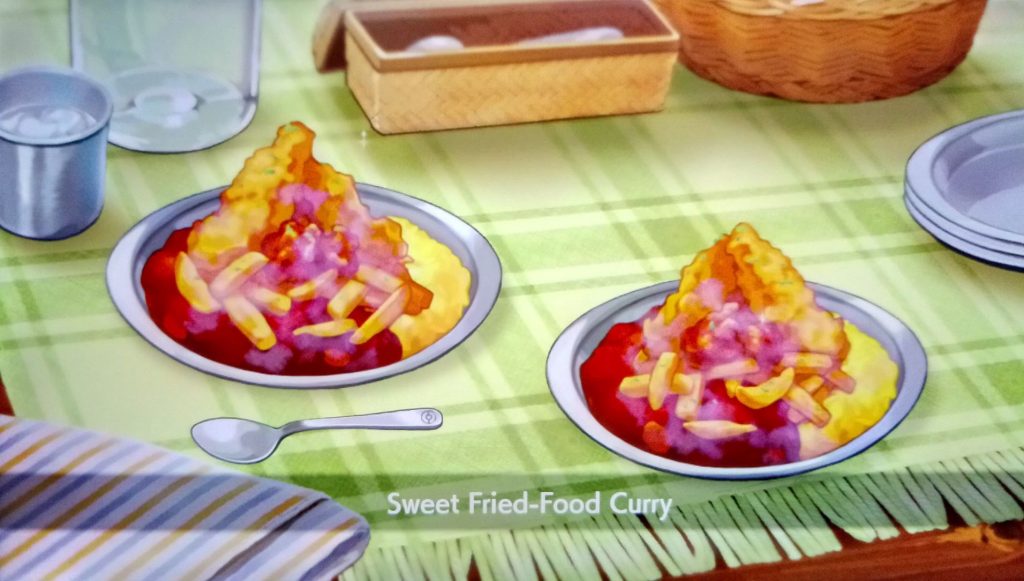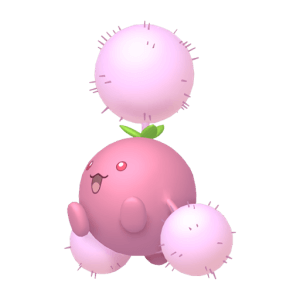Okay, trainers – let’s get cooking!
One of the signature features of Pokémon: Sword and Shield is of course the opportunity to go camping with your Pokémon – and cook them up a nice plate of curry and rice to restore their energy and win their undying affection.

As described by an NPC called the “Camping Master,” who hangs out by the Motostoke entrance to the Wild Area, a Galarian curry is basically a sauce made from blended berries, served with rice and some other ingredient or topping. Considering the range of different berries and other ingredients the games offer us, this can result in a number of things that – I would argue – barely qualify as food, let alone “curry,” but fundamentally the definition isn’t a bad one.
“Curry” in the real world can be any of a huge variety of fruit-, dairy- or broth-based sauces, flavoured with spices (usually including hot chillies) and served with rice and vegetables or meat. In the modern era, curry has spread all over the world from its home in India, and everyone now has their own idea of what it should taste like – especially the English and the Scots, and their Pokéverse counterparts, the Galarians. Now, I don’t really have any useful skills or initiative, so while all the other PokéJungle writers are doing good work to write helpful guides about the new content in Sword and Shield, I thought I’d make some curry instead – and you can make it with me!
Today’s project: the “fried food curry”!

Sword and Shield’s “fried food curry” bears a lot of resemblance to the British fast-food staple of fish and chips* with curry sauce. It is bizarre and, by the standards of almost any of the regional cuisines of the Indian subcontinent, an absolute culinary abomination, but as an example of modern British food it’s absolutely authentic. In principle, you can have fish and chips with any kind of curry sauce – personally I recommend a vindaloo – but there is also a standard British fish-and-chip curry sauce. It’s usually sweeter and less spicy than what we might normally think of as “curry” (which makes sense, since you use it the way you’d use a tomato ketchup); it features pureed apples and often raisins, and a lot of the spiciness it has comes from ginger. If you’re in the UK, New Zealand, or another country with a robust fish-and-chip tradition, it would sort of be in the spirit of this dish to just go out and buy some from your local chippie. After all, in the game, the core ingredient of this curry is a box of last night’s awful greasy leftovers. However, I believe in doing everything the hard way, so I’m going to do some beer-battered fish from scratch. Here goes nothing…
* Note for American readers: in British English, “chips” are thick-cut fries, and the crunchy things are “crisps.” Before you complain, know that in New Zealand, where I come from, we call both of those things “chips,” so if we can keep them straight, so can you.
Curry Fish and Chips Recipe
Curry Sauce:
- 1 shallot or ½ a small onion, finely chopped
- 2-3 cloves garlic, crushed or finely chopped
- ½ an apple, peeled and diced (eat the other half, or don’t; I’m not here to judge you)
- 2-3 cm fresh ginger, grated (1 tsp of ground ginger will do if you can’t get it fresh)
- 1 tomato, quartered, with seed goop removed
- 40g golden raisins (about 1 small handful)
- ½ cup chicken stock
- 1 tsp cornflour (= corn starch), dissolved in cold water
This version uses a little Worcestershire (inexplicably pronounced “whooster”) sauce, which is not a standard ingredient in this sauce and may be difficult to find in the US, but I think it adds a nice umami undertone, and it’s definitely a very British ingredient.
Spices:
- ½ tsp curry powder
- ½ tsp cumin
- ½ tsp coriander
- ¼ tsp cinnamon
- ¼ tsp turmeric
- (if you aren’t a crazy person like me, and you only have a few spices in your kitchen, cut the cumin, coriander and turmeric and just use a full teaspoon of curry powder and a little cinnamon)
Instructions:
- Finely chop shallot; peel and dice apple; crush or finely chop garlic; grate ginger. Fry gently in butter or oil until the onions begin to brown.
- Add spices and stir for 30 seconds or so.
- Add chicken stock, tomato and raisins, then bring to a boil and cook until the tomato pieces are mushy.
- Add the cornflour, stirring vigorously to prevent lumps from forming.
- Remove from heat and allow to cool for a few minutes (you can start working on the fish and chips while you wait, if you like).
- Blitz everything in a food processor until smooth.
Fish and Chips:
- 1 large potato
- 100-200g fish fillets (I used cod here; at home we’d use snapper, orange roughy or tarakihi; you could also use tilapia, bass, trout, whatever’s available in your area)
Beer Batter:
- ½ of a 355 ml/12 oz can of cold beer
- ¾ cup flour, + another ½ cup for dusting
- ¼ cup cornflour
- 2 tsp garlic powder
- 1 tsp salt
Instructions:
- Peel the potato and cut into long strips. Bear in mind that these will shrink when fried, so don’t cut them too thin.
- Pat the chips dry with paper towels. Try to remove as much moisture as you can.
- Cut your fish fillets lengthways into pieces 2-3 cm thick (unless they’re already thinner than that).
- Pat the fish dry as well.
- Mix the flour, cornflour, garlic powder and salt in a bowl.
- Pour in the beer, whisking gently until just combined (the beer is supposed to make the batter a little bit bubbly, so don’t stir too hard).
- Thickly coat your fish pieces in beer batter, then toss them in your extra flour.
- Fill a frying pan with oil to about 2 cm deep and heat it up to 170 ºC (= 340 ºF), then add the chips. Be careful as the hot oil may spit.
- Fry the chips for at least 12 minutes. If they start to turn brown, the oil is too hot – in this first fry, we only want to drive off as much water as possible.
- Once the chips have noticeably shrunk, remove the pan from the heat and take them out with a slotted spoon. Put them on a paper towel-lined plate to drain, and use more paper towels to pat them dry (do this whenever you finish frying anything, otherwise the excess oil will make it greasy).
- Increase the heat to 190 ºC (= 375 ºF), then fry the fish until golden brown.
- Take out the fish, then return the chips to the oil for a quick, high-temperature fry (1-2 minutes) to get them golden brown and crispy.
- Liberally sprinkle the fish and chips with salt before serving.
Rice:
I’ll be serving all my curries with 1/3 cup of brown rice (which I prefer to white rice because it has more of its own flavour, but you should use whatever you have), boiled in about 1 cup of water with ½ tsp of salt, then drained and tossed with ½ tsp of turmeric to get the golden colour of the rice we see in the game. The turmeric is purely cosmetic here, and if you don’t like the taste you can leave it out.
For extra Britishness points, splash a bit of malt vinegar over everything just before you start eating.

Fewer sparkles than the game version, and the curry sauce is a different colour (you could use smoked paprika instead of turmeric for something closer to the deep red of the game’s curries, although that would alter the flavour), but not a terrible imitation.
Of course, we have to give this a rating… drumroll, please?

I rate this curry: Milcery-class!
Frankly, the chips drag the dish down a bit. It takes a lot of practice to get them right, and they should really be done in a deep-fryer (which I don’t have), so in my opinion there’d be no shame in doing this with some oven-baked potato wedges or something. The fish turned out beautifully though, and I like combining sweet and savoury, so the apple- and raisin-based curry sauce is a great pairing with the fried fish and rice for me. I probably wouldn’t make this if I were having friends for dinner, but next time I have a craving for fish, I’ll probably come back to it.
Other things you could try here:
The game dialogue recommends using berries with “dry” flavours to offset the greasiness of the fried food. I’ve never quite understood what Pokémon means by “dry” flavours, because in English we normally only use “dry” to describe flavour when talking about alcoholic drinks (in Japanese, the word is 渋い, shibui, which is a difficult-to-translate word somewhere between sour and bitter). However, the most common Pokémon berry with a “dry” flavour is the Chesto, which seems more like a nut than a berry, so you could experiment with some nutty flavours. Instead of the raisins, try some hazelnuts, ground up in a food processor and then gently toasted in a dry frying pan (you may not need as much cornflour in this version, as the ground nuts will help to thicken the sauce). Hazelnuts with apple and spices? Call me crazy, but I think that might work.
Alternatively, the game doesn’t really specify what it means by “fried food” – fish and chips would be the classic, but I think anything you’d find at a neighbourhood chip shop is fair game. Onion rings, pineapple fritters, battered scallops, calamari, the world is your oyster. Oh, battered oysters; there’s another one.
If all that left you hungry for more Galarian food, join me next time as I tackle the most British curry of all: chicken tikka masala!
…assuming PokéJungle doesn’t just fire me for wasting everyone’s time with this nonsense. Let me know if you tried cooking it or want to attempt to make any other curries you’ve seen in-game!
For more Pokémon Sword & Shield discussions, go to our Discord server!










